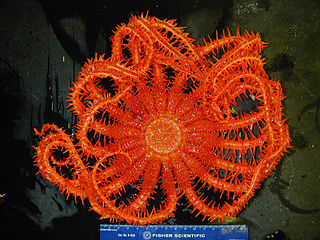Related Research Articles

Starfish or sea stars are star-shaped echinoderms belonging to the class Asteroidea. Common usage frequently finds these names being also applied to ophiuroids, which are correctly referred to as brittle stars or basket stars. Starfish are also known as Asteroids due to being in the class Asteroidea. About 1,500 species of starfish occur on the seabed in all the world's oceans, from the tropics to frigid polar waters. They are found from the intertidal zone down to abyssal depths, 6,000 m (20,000 ft) below the surface.

Asterias is a genus of the Asteriidae family of sea stars. It includes several of the best-known species of sea stars, including the (Atlantic) common starfish, Asterias rubens, and the northern Pacific seastar, Asterias amurensis. The genus contains a total of eight species in all. All species have five arms and are native to shallow oceanic areas of cold to temperate parts of the Holarctic. These starfish have planktonic larvae. Asterias amurensis is an invasive species in Australia and can in some years become a pest in the Japanese mariculture industry.

Asterias amurensis, also known as the Northern Pacific seastar and Japanese common starfish, is a seastar found in shallow seas and estuaries, native to the coasts of northern China, Korea, far eastern Russia, Japan, Alaska, the Aleutian Islands and British Columbia in Canada. Two forms are recognised: the nominate and formarobusta from the Strait of Tartary. It mostly preys on large bivalve molluscs, and it is mostly preyed on by other species of starfish. Population booms in Japan can affect the harvest of mariculture operations and are costly to combat.

Solaster paxillatus, the orange sun star, is a species of starfish found at varying depths in the northern Pacific Ocean. It is a natural predator of the starfish Asterias amurensis.

The common starfish, common sea star or sugar starfish is the most common and familiar starfish in the north-east Atlantic. Belonging to the family Asteriidae, it has five arms and usually grows to between 10–30 cm across, although larger specimens are known. The common starfish is usually orange or brownish in color, and sometimes violet; specimens found in deeper waters are pale. The common starfish is found on rocky and gravelly substrates where it feeds on mollusks and other benthic invertebrates.

Asterina is a genus of asteroideans in the family Asterinidae.

The Forcipulatida are an order of sea stars, containing three families and 49 genera.

The Brisingids are deep-sea-dwelling starfish in the order Brisingida.

Henricia is a large genus of slender-armed sea stars belonging to the family Echinasteridae. It contains about fifty species.

Asterias forbesi, commonly known as Forbes sea star, is a species of starfish in the family Asteriidae. It is found in shallow waters in the northwest Atlantic Ocean and the Caribbean Sea.

Evasterias troschelii is a species of starfish in the family Asteriidae. Its common names include the mottled star, false ochre sea star and Troschel's true star. It is found in Kamchatka and the north western coast of North America.

Orthasterias is a genus of sea stars in the family Asteriidae. Orthasterias koehleri, the rainbow star or red-banded sea star, is the only species in the genus. It is found in the North Pacific Ocean.

The spiny sand seastar is a species of starfish in the family Luidiidae. It is found in shallow parts of the China Sea and in the vicinity of the Korean archipelago. The tissues of this starfish have been found to contain several secondary metabolites with medicinal potential.

The Brisingidae are a family of starfish found only in the deep sea. They inhabit both the Atlantic and Pacific Oceans at abyssal depths, and also occur in the Southern Ocean and around Antarctica at slightly shallower depths.
Metrodira subulata is a species of starfish in the family Echinasteridae. It is found on the seabed in shallow parts of the Indo-Pacific region.

Euretaster insignis, commonly known as the striking sea star, is a species of starfish in the family Pterasteridae found in the central west Pacific Ocean. It is one of only three species in the order Velatida to be found in shallow water in the tropics. The young are brooded in a cavity underneath a "supradorsal" membrane.

Asterias rollestoni is a common starfish native to the seas of China and Japan, and not known from the far north or the American coasts of the eastern Pacific.
Asterias rathbuni is a starfish native to the Pacific coasts of Alaska in the United States and Far East Russia. There are two subspecies.
Asterias microdiscus is a starfish native to the Pacific coasts of Far East Russia.
Asterias versicolor is a species of starfish native to the southern coasts of Japan southwards to the South China Sea.
References
- 1 2 3 4 5 6 Дьяконов, А.М. (1950). Морские звезды морей СССР [Определители по фауне. 34 (Tableaux analytiques de la faune de l'URSS 34)] (in Russian). St. Petersburg: Акаде́мии Нау́к СССР. p. 124.
- 1 2 Mah, Christopher L. (2008). "Asterias argonauta Djakonov, 1950". World Register of Marine Species (WoRMS). Flanders Marine Institute. Retrieved 13 November 2019.
- ↑ Jangoux, Michel; Lawrence, John M. (1 June 2001). Echinoderm studies 6. CRC Press. p. 260. ISBN 9789058093011.
- 1 2 Smirnov, Igor S. (2019). "Sea Stars (Asteroidea) Catalogue • Asterias". Research Collections of the Zoological Institute RAS. Zoological Institute of the Russian Academy of Sciences. Retrieved 13 November 2019.
- ↑ Smirnov I, Khalikov R (2019). Catalogue of the type specimens of sea stars (Asteroidea, Echinodermata) from research collections of the Zoological Institute, Russian Academy of Sciences. Version 1.11. Zoological Institute, Russian Academy of Sciences, St. Petersburg. Checklist dataset https://doi.org/10.15468/3vvua7 accessed via GBIF.org on 2019-11-18. https://www.gbif.org/occurrence/1899866107